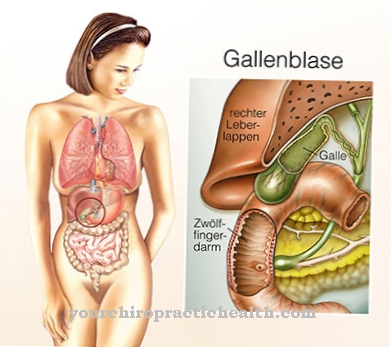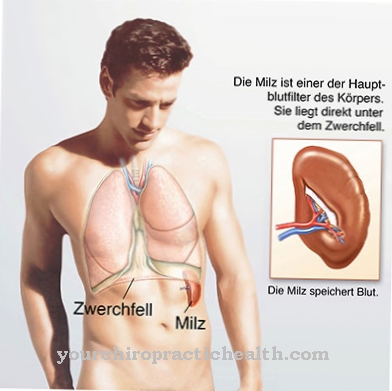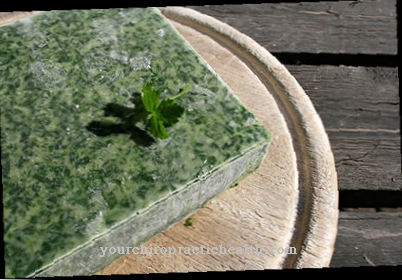A Bone cyst is a benign, tumor-like change on the bone that is filled with fluid. Often, bone cysts do not cause any symptoms and are therefore only discovered by chance as part of another disease. Treatment is not required in every case, it depends on the individual case.
What is a bone cyst?

© stockshoppe - stock.adobe.com
A bone cyst is a benign, non-tumorous change in the bone. They consist of fluid-filled cavities in the bone that can vary in size.
Children up to 15 years of age are often affected by bone cysts, but boys are more often affected than girls. In many cases, bone cysts do not cause any symptoms and are therefore only discovered by chance during examinations. In other cases, the bone cysts grow together completely unnoticed at the end of the growth process, have never caused symptoms and are therefore not noticed.
However, even if a bone cyst is discovered, treatment is not always required. If there is no risk of secondary diseases, one can simply wait until the cyst grows together. When it comes to bone cysts, a distinction is made between juvenile bone cysts (single-combed) and aneurysmal bone cysts (multi-combed).
causes
The exact causes for the development of a bone cyst are unknown. However, it is believed that injuries to the bone or blood clots can trigger bone cysts. Inflammation or developmental disorders are also seen as possible causes.
Bone cysts mainly affect children up to around the age of 15, and they also occur less frequently in young adults. Most often, bone cysts occur in children up to. 10 years of age. Bone cysts in children most often appear in the humerus or thigh bone.
Since they very often do not cause any symptoms, they are often only discovered by chance. Such as if there is a broken bone and an X-ray examination is therefore necessary. In some cases, bone cysts can also be responsible for a bone fracture because they reduce the stability of the bone.
Symptoms, ailments & signs
Bone cysts usually do not cause any noticeable discomfort. However, a cyst in the area of the bone increases the risk of fractures. The overgrowth affects the stability of the affected bone, and the blood flow in the surrounding area can also be reduced or completely cut off by the cyst.
If no more blood gets into the surrounding tissue, serious complications up to necrosis can develop. In individual cases, bone cysts can cause pain. Those affected then suffer from indefinable, pulling pain that occurs primarily when stimuli such as cold or heat occur. Large cysts can cause persistent pain and thereby affect your well-being.
Visible swelling or reddening of the skin rarely forms. However, these are usually not associated with pain and quickly subside. Bone cysts in the head, spine, genital area and knee can cause various functional disorders. Bone cysts usually form suddenly and are only discovered much later.
They grow quickly but are relatively harmless due to their benign shape. Usually they connect to the surrounding tissue as soon as the growth phase is complete. The bone cysts can then no longer be seen on the X-ray.
Diagnosis & course
Bone cysts usually do not cause any discomfort to those affected, which is why a doctor is rarely consulted about it. If a bone fracture occurs, a bone cyst may be responsible and is often discovered when a bone fracture is diagnosed more precisely using an X-ray examination. A bone cyst can be seen as a bright spot on the X-ray.
When a bone cyst is discovered, the decisive factor is whether the cyst poses a risk to the bone. This is always the case when the stability of the bone is limited by the bone cyst and there is a risk of a bone fracture. Treatment should also be given if the bone cyst is responsible for a broken bone.
In all other cases, therapy is not necessary as most of the bone cysts disappear on their own as they grow. At the end of the growth phase, at the latest, bone cysts can no longer be recognized.
Complications
A bone cyst does not always have to lead to complications or limitations. It is usually benign and therefore does not always need treatment. Those affected can suffer from developmental disorders or movement disorders and restrictions in everyday life due to the bone cyst. In most cases, however, there is no pain.
Patients also suffer more from bone fractures, making them easier and easier to occur. The stability of the bones and thus the entire body decreases. The affected person is usually less resilient as a result. If the cyst is not dangerous to the bone, it is usually not removed or treated further.
Most of the time, the cysts are discovered only by chance during check-ups. However, if there are symptoms, these can also be treated with the help of cortisone. There are no complications. Surgical treatment is also possible. The patient's life expectancy is not reduced by this disease. Only in rare cases are there restrictions in the patient's everyday life.
When should you go to the doctor?
Repeated bone fractures and pain or swelling around the bones may have a bone cyst. Medical advice is required if the symptoms have a significant effect on well-being, do not subside on their own or become worse within a short time. Chronic complaints must always be clarified by a specialist and treated if necessary. Otherwise, serious complications can arise. If there are additional symptoms, it is best to see a doctor on the same day.
In the case of recurring complaints for which no cause can be found, a specialist should be called in. A pediatrician should be seen with children who complain of bone pain. The first point of contact should always be your family doctor or an orthopedic surgeon. Close consultation with the doctor is necessary during treatment. If side effects and interactions occur after taking the prescribed medication, this must be clarified as well as recurring pain and other symptoms.
Doctors & therapists in your area
Treatment & Therapy
Treatment for a bone cyst is based on its size and possible effects on the body. In many cases, no treatment is necessary, as consequential damage from the bone cyst can largely be ruled out.
If there is an increased risk of a bone fracture due to the bone cyst, appropriate therapies should be initiated to eliminate the cyst and thus prevent a bone fracture.
Juvenile bone cysts can be treated very well with cortisone. The cortisone is injected directly into the cyst and causes the bone cyst to gradually disappear. In some cases it may be necessary to remove the bone cyst with an intervention and to fill the cavity with bone material. This measure is the treatment method that is most likely to be successful. So-called decompression screws can also be inserted into the bone. These ensure that the bone cyst heals.
In the case of an aneurysmal bone cyst, however, therapy is more often required to prevent permanent damage to the bone. Since an aneurysmal bone cyst, in contrast to the juvenile bone cyst, has a very good blood supply, this species has very strong growth. The bone substance is increasingly used up and the bone is damaged and unstable.
Therefore, aneurysmal bone cysts can also cause pain. Treatment of the bone cyst is recommended in these cases. Mostly it is a surgical procedure in which the cyst is emptied and filled with bone material or cement. However, the aneurysmal bone cyst is a very rare disease.
Outlook & forecast
The prognosis for a bone cyst is usually favorable. It is a benign change that is usually only diagnosed by chance in children and adolescents. The cyst rarely causes physical discomfort. For this reason, some people affected may have bone cysts in their organism for a long time and still not notice any impairment in everyday life.
A shortening of the lifespan or other secondary diseases are also not given with this disorder. Often no treatment is required or carried out due to the low need for action. The diagnosis is made in a large number of patients because of a broken bone. This could possibly have been caused by a cyst. With early and professional medical care, the bone fracture heals completely without further complications within a few weeks or months. If this has not already been done independently, the existing cyst is removed during the treatment. There are usually no residues or further inconveniences.
Despite the favorable prognosis, the cyst can develop again as the child continues to develop. The chances of recovery and the course of the disease remain positive in these cases. If the bone cyst is noticed, it can be removed if desired.
prevention
Since the causes of bone cysts are not clearly understood, there can be no direct recommendation for prevention. The causes that are suspected to trigger a bone cyst are difficult or impossible to influence.
Aftercare
The removal of the bone cyst is often uncomplicated, so that costly aftercare is not necessary in many cases. However, there are a few things to consider after surgery. Immediately after the operation, it is important to look out for signs of a rare infection in the operated area. The typical symptoms such as redness, overheating, swelling and throbbing pain are reasons for a visit to the doctor. This is especially true in the case of a fever. The earlier an infection is detected, the better it is usually treated.
The second point of aftercare concerns the functionality of the affected bone. The wearing of plaster of paris and the protection of the affected area are really only to be carried out for as long as the attending physician recommends. He can assess when the bones can again be adequately resilient to meet the demands of everyday life, work and leisure.
Taking too long as part of aftercare can also be counterproductive if it is at the expense of strength and mobility.If the resilience is to be increased gradually, this can be accompanied by a physiotherapist. Sport in aftercare should be discussed with the doctor. In particular, avoid strong compression caused by jumps and the risk of injuring yourself in a duel.
You can do that yourself
In the case of a bone cyst, the person affected usually does not have any special options for self-help. The further treatment of such a cyst depends on its position and severity, although treatment or removal is not necessary in every case. The bone cysts are usually treated with the help of cortisone, which results in a positive course of the disease. Those affected should, however, avoid broken bones and thus dangerous sports or activities in general.
If the bone cyst causes pain, pain medication can also be taken. These should only not be taken for a long period of time, as they can damage the stomach. The doctor may also give the patient a local pain reliever injection to relieve the discomfort.
If the bone cyst leads to psychological complaints, conversations with other patients or with close friends and family are suitable. By exchanging information with other patients, everyday life can often be made more pleasant. Other people's experiences of success can also resolve psychological complaints and accelerate the healing of the disease.

.jpg)

.jpg)























